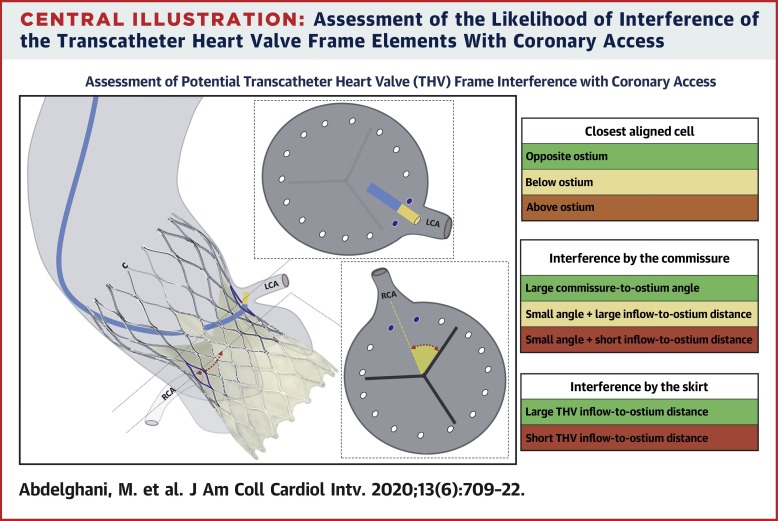JACC: Cardiovascular Interventions ( IF 11.7 ) Pub Date : 2020-03-16 , DOI: 10.1016/j.jcin.2020.01.229 Mohammad Abdelghani 1 , Martin Landt 2 , Hussein Traboulsi 2 , Björn Becker 2 , Gert Richardt 2

|
Objectives
The authors sought to estimate possible interference of the Medtronic Evolut R/Pro transcatheter heart valve (THV) frame with coronary access using multislice computed tomography (MSCT) data.
Background
Lower-risk patients undergoing transcatheter aortic valve replacement (TAVR) endure a high cumulative risk of coronary events, but coronary access can be challenging.
Methods
In 101 patients who received an Evolut R/Pro THV, post-TAVR MSCT (performed at a median of 30 days after TAVR) was used to assess possible interference of the elements of the THV frame with coronary access.
Results
The closest cell of the THV frame vertically aligned with the coronary ostium was located opposite the ostium in 58% and 63%, below the ostium in 22% and 30%, or above the ostium in 20% and 7% of left and right coronary arteries, respectively. The free sinus of Valsalva space between the THV frame and the coronary ostium was 0.45 ± 0.17 cm and 0.44 ± 0.17 cm for the left and right coronary arteries, respectively, and showed a stepwise decrease with decreasing THV size (p < 0.001). Bioprosthetic valve commissures were antianatomic (i.e., not aligned with native commissures) in 45 patients (47%), and the commissural post was overlapping a coronary ostium in 15 patients (16%). Two patients (2.0%) had a possible interference of the paravalvular sealing skirt with coronary access.
Conclusions
Using post-TAVR MSCT data, the main mechanism of potential interference of Evolut R/Pro frame with coronary access was an antianatomic commissural post overlapping the coronary ostium.
中文翻译:

自扩张生物假体TAVR后的冠状动脉通路:计算机断层扫描的见解。
目标
作者试图使用多层计算机断层扫描(MSCT)数据估计Medtronic Evolut R / Pro经导管心脏瓣膜(THV)框架对冠状动脉介入的可能干扰。
背景
接受经导管主动脉瓣置换术(TAVR)的低危患者承受冠状动脉事件的高累积风险,但冠状动脉通路可能具有挑战性。
方法
在接受Evolut R / Pro THV的101例患者中,TAVR后MSCT(在TAVR后中位数30天执行)用于评估THV框架元素对冠脉介入的可能干扰。
结果
与冠状动脉口垂直对齐的THV框架中最靠近的细胞位于左冠状动脉的对面,分别为58%和63%,在口之下,分别为22%和30%,或在口之上,分别为左右冠状动脉的20%和7%动脉。THV框架和冠状动脉口之间的Valsalva间隙的游离窦分别为左冠状动脉和右冠状动脉,分别为0.45±0.17 cm和0.44±0.17 cm,并且随着THV尺寸的减小而逐步减小(p <0.001)。45例患者(47%)的生物瓣膜连合是解剖性的(即与自然连合不符),而15例患者(16%)的连合处与冠状动脉口重叠。两名患者(2.0%)可能会干扰冠状动脉旁瓣旁裙缘。
结论
使用TAVR后的MSCT数据,Evolut R / Pro框架对冠状动脉介入的潜在干扰的主要机制是与冠状动脉口重叠的解剖解剖连合。











































 京公网安备 11010802027423号
京公网安备 11010802027423号